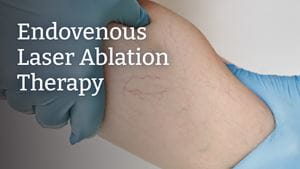
Until recently, the only treatment option available for venous insufficiency was a major surgery called vein stripping. Vein stripping is an invasive procedure with a long recovery that frequently failed after a few years. Over the past decade, a revolutionary new treatment has been developed. The procedure is performed by interventional radiologists, who are experts in imaging and minimally invasive treatments.
Endovenous Laser Ablation Therapy (EVLT) takes approximately 45 minutes and is performed as an outpatient procedure using local anesthesia. It involves minimal pain, no scarring, quick recovery and immediate return to most normal routines.
EVLT is performed using ultrasound imaging guidance. Instead of pulling the vein out, as is done in vein stripping, the problematic vein is gently heated and sealed shut from the inside using a sophisticated laser fiber. This is done through an opening in the skin not much larger than one needed for a typical IV.
After applying local anesthetic to the skin, the interventional radiologist inserts a catheter, which is like an IV, into the vein. An ultrasound is used to expertly guide the catheter up the vein to an exact location. After numbing the area around the vein, laser energy is then applied to the inside of the vein, heating the vein and sealing it closed. By closing the problematic vein, the twisted and varicosed branch veins closest to the skin also shrink and improve in appearance. Once the diseased veins are closed, the blood is rerouted to normal, healthy deep veins – causing the pain and symptoms to begin to disappear.
It is also important to wear loose-fitting pants and loose shoes to allow room for thick bandages and compression garments. You must also bring your prescription Class II stockings with you. Failure to do so will require your appointment to be rescheduled for a later date. We also ask that you not schedule any long car or plane rides for at least two weeks after your procedure.
The EVLT tube, or catheter, will be inserted into the vein under ultrasound control, and the tip is positioned at the top of the vein. Once the laser tip is confirmed in place and the device is turned on, the laser is slowly retracted over 2-3 minutes, a process which the patient generally does not feel. Compression is then applied by a combination of bandages and compression garments.
You may need to return later to complete treatment with ultrasound-guided sclerotherapy of the residual varicosities.
If you experience minor soreness and bruising, you can take over-the-counter medication as needed. Periodic ultrasound examinations will confirm that the vein remains closed.
Note: Do not take Ibuprofen, as it may interfere with the vein closing.
You may also experience some inflammation and bruising around the treated areas.